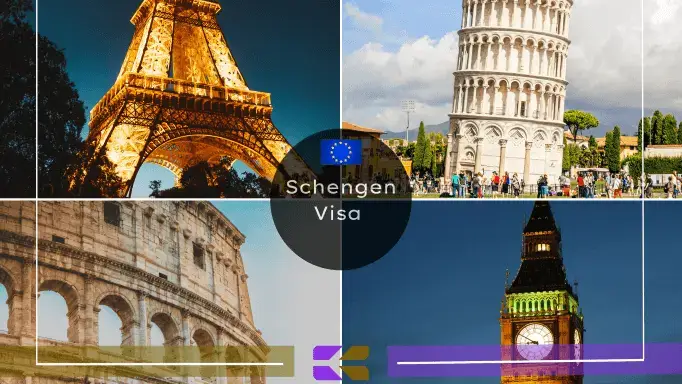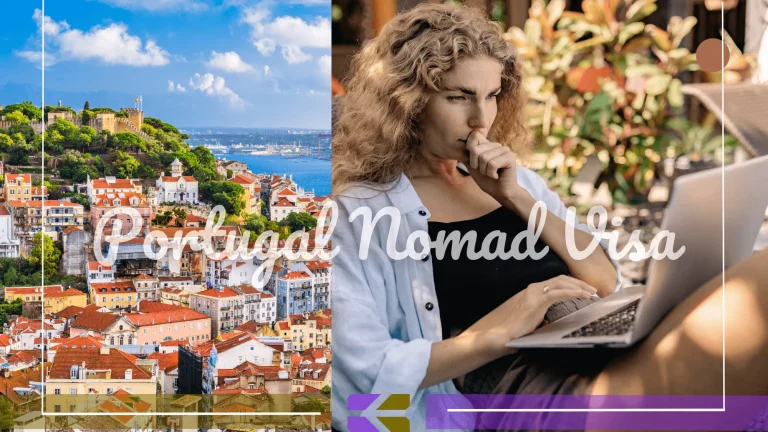Schengen Visa | The Key to an Unforgettable European Adventure
Schengen Visa
We have all met someone at least once in our lives who flaunts how one passport they own gives them access to half the world. We have looked at them in confusion and awe. We have wondered curiously how that’s possible.
The name Schengen Visa sounds like an attractive foreign scheme. Which it is. So, whether you are just curious about it or want to learn everything to acquire it, here’s everything you need to know about the infamous Schengen travel permit.
The Schengen travel permit is one of the most sought-after documents for traveling like Golden Visa. It creates ease during your visits to European countries while also ensuring that you are not subjected to internal checks. Just one visa that offers several benefits is definitely one that you should apply for if you want to enter Europe!
Schengen Visa – What Is It?
Deemed the most common permit type among American, Canadian, Indian, and other Asians, it allows individuals to travel freely within Europe and some non-European Union states. By acquiring it, you can travel to almost 26 countries that are part of the Schengen zone without the need for another visa.
One of the biggest advantages is the fact that you can enter and leave any Schengen state as you, please. There are no internal border checks when you travel to a country that comes under the Schengen jurisdiction. As long as your visa is valid, you are a free bird who can travel from one Schengen zone to another!
If your work or other activities require you to travel through European Union constantly, this is it for you. A Schengen passport just might be the key that solves all your issues. No more running around renewing permits for every country. Just apply for the Schengen card and you are good to go. But before you do so, you must know about the Schengen zone.
The Schengen Zone
The Schengen Zone comprises some non-EU countries along with 22 countries belonging to the EU. The Schengen area includes the following countries:
Non-European Union zones
- Iceland
- Liechtenstein
- Norway
- Switzerland
European Union Zones
- Austria
- Belgium
- Czech Republic
- Denmark
- Estonia
- Finland
- France
- Germany
- Greece
- Hungary
- Italy
- Latvia
- Lithuania
- Luxembourg
- Malta
- Netherlands
- Poland
- Portugal
- Spain
- Slovakia
- Slovenia
- Sweden
Additionally, there are some non-Schengen countries that allow valid Schengen card holders to stay and travel within the country. They might not be a part of the Schengen zone but if you have a valid Schengen visa, you can easily transit through or temporarily visit them.
The Non-Schengen countries that allow Schengen holders permit-free travel are:
- Albania
- Antigua and Barbuda
- Belarus
- Bosnia and Herzegovina
- Bulgaria
- Croatia
- Columbia
- Georgia
- Gibraltar
- Kosovo
- Mexico
- Montenegro
- North Macedonia
- Northern Cyprus
- Romania
- Serbia
- Turkey
However, they do have specific requirements. Make sure you meet those requirements before flying toward these countries.
The Schengen passport and travel permit are certainly a scheme that appeals to many. With its multiple benefits and close to no disadvantages, most people who apply for Europe, apply for a Schengen card.
This arises one specific question in our minds; “How did it all begin?”
Before we tell you more about it, let us take you back to where it all started. To know everything, you must know the history too.
Through The Lens Of History: The Schengen Agreement
The creation of the Schengen card came right after the Schengen Agreement was signed. It’s a treaty between the Federal Republic of some European countries that were signed in 1985 in order to abolish the conventional bordered countries. Named after the town of Luxembourg where the agreement was signed, it was put in place to create a unified European Union that will
later be known as the “Schengen Zone”.
Initially, the agreement was signed between Belgium, France, Germany, Luxembourg, and the Netherlands. At the time, the key points of the agreement included:
- Gradual abolishment of border checks among the signatories’ internal borders.
- Freedom for citizens of the agreeing countries to move freely and cross borders easily.
- Decreased vehicle checks.
- Visa Policy harmonization
- Combating cross-border drug crimes
- Asylum matters
- Police and judicial cooperation amongst the signatories’
When the agreement was first signed, it acted independently of the European Union. However, in 1999, the Schengen agreement became incorporated into the law of the EU via the Amsterdam Treaty. Hence, this led to the creation of the Schengen Area which is essentially a single state with respect to travel policies.
Now that we know the history of Schengen, let’s move on.
Types Of The Schengen Card – A Complete Guide
The three main categories of the Schengen card are mentioned below. Each category comes with its own set of rules, regulations, requirements, and limitations. Whichever type of Schengen permit you apply for, you must remember to follow their guidelines to become eligible and to get your application accepted.
Uniform Schengen Visa
The uniform Schengen is the commonest type of permit that most people apply for. It’s basically the short-stay permit that allows you to transit and travel through the Schengen zone. It provides access to all the countries within the Schengen area. Through the uniform stamp, you can stay in a Schengen country for 90 days within a period of 6 months.
According to the purpose of your application, the uniform Schengen permit can be obtained in the form:
Airport-Transit Permit
As its name suggests, the Airport-transit permit allows cardholders to transit through a Schengen airport. Commonly known as type A Schengen permit, it is necessary for everyone who plans to transit through any of the countries within the Schengen zone. Travelers with connecting flights through the area are required to apply for this permit. Otherwise, they won’t be allowed to transit
through.
Short Stay Permit
The next category of the USV is Category C, also known as the Short stay permit. It allows its holders to travel visa-free within the zone. People who wish to travel, stay, and reside in the area for a short time are required to apply for this type.
The permit grants access to the entire Schengen zone. You can enter and leave the countries whenever you want. However, since it only allows short stays, its holders can only reside in the countries for a limited amount of time. You can
It is further divided into the following three types:
Single-entry
The single-entry permit only grants one-time access to the Schengen zone. It allows its holders to enter the country for a single time. This means that once you leave the country, you won’t be allowed back without renewal.
Double-entry
The Double-entry permit allows an individual to enter the country two times only. It means that you can leave the territory and re-enter again as long as you have a valid permit. However, once you leave the country again, you can’t travel freely without renewing your documents and application.
Multiple-entry
The multiple-entry visa (MEV) allows its holders to enter and leave the Schengen zone as many times as they wish. It is perfect for people who are constantly traveling through Europe for business or any other purposes.
The only limitation is that you can only stay for 90 days in the country within a 180-day period. Don’t worry though, it remains valid for at least a year. So, once the 180-day mark is over, you can re-enter again.
The multiple-entry permits can either be valid for 1, 3, or 5 years.
1-year Multiple-entry: Allows its holders to enter Schengen states as many times as they want. The holder must follow the 90/180 rule. But after 180 days, you can enter the country again. This type of MEV is given to people who have lawfully obtained and used three visas prior to the application in the last two years.
3-year Multiple-entry: It allows its applicants to enter and leave the territory whenever they want for 3 years. You must also follow the 90/180 rule for this one too. To become eligible for the 3-year multiple-entry permit, you must have lawfully obtained and used an MEV for one year within the last two years.
5-year Multiple-entry: It grants access for 5 years to the Schengen states as long as you follow the 90/180 rule. You can get this permit if you have lawfully obtained and used an MEV for two years in the last three years.
National Visa
Most commonly known as type D, the national permit is compulsory for any individual who plans to stay in a Schengen country for more than 90 days. The purpose of stay can either be work or studies but you must have documentation proof for your application.
Type D can either be a single-entry permit that allows its holders to enter the country only once. On the other hand, you can also apply for a multiple-entry permit if your work or studies require you to enter and leave the country multiple times. It also grants permit-free access to other countries in the Schengen region.
Limited Territorial Validity Visa (LTVV)
The LTVV allows its holders to transit and travel through one or more specific Schengen states only. If you have applied for it, you must understand that you can not travel freely within the Schengen zone. You must stick to the states you are allowed to travel in. This type of permit is only provided in special cases such as for humanitarian reasons or emergency cases.
The above-mentioned are the basic types of the Schengen permit. Apart from this, different types are also available.
Types On The Basis Of Purpose Of Travel
- Transit (Airport or Sea): This type of travel permit is required when you are transiting through a specific country by air or sea.
- Tourism: It allows you to travel freely within the zone for sightseeing and tourism.
- Family or friends visit: f you have to visit a friend or family residing in the Schengen state, you must apply for this one.
- Official Visit: This type of permit provides access to the zone for official visits such as diplomats or similar reasons.
- Business: If you wish to travel to any of these states with the intent of doing business, this is the permit for you.
- Medical reason: Many people travel to and from European countries for various medical reasons. This allows them to travel permit-free within the Schengen zone.
- Study or research purposes: If you want to travel from Pakistan or India to a Schengen zone for study or research purposes, you must apply for a study permit. It is valid for as long as you are studying. Once your studies end, you must go back to your country.
Schengen Permit Based On Different Countries
Eligibility Criteria For All Types Of Schengen Travel Permits
To become eligible to apply for the permit you must be on par with the following criteria:
● The applicant must be a citizen of a Non-European Union Country.
● The applicant must be of legal age (18 years).
● The applicant must have a valid travel document i.e passport with an expiration date at least after 3 months of your desired period of travel.
● Must have medical insurance worth at least €30,000.
● The applicant must be able to provide all the necessary documents.
● Must have a clear criminal record.
If you fulfill the above criteria, you are eligible to apply for the document. Before you apply, make sure you have all the necessary documentation and requirements.
Requirements
The general documents that are required to apply for the Schengen travel permit are:
● A valid passport: Must not be older than 10 years. The expiration date must be at least 3 months after you plan to leave the country.
● Two passport-sized photographs taken within the past three months.
● A complete travel itinerary along with round trip flight numbers and dates for both entry and exit out of the Schengen states.
● Proof of accommodation: This proves that you have a place to stay during your visit. It can either be a hotel reservation, letter of invitation, rental document, or hostel information.
● Proof that you have enough finances to support yourself and any family member coming along with you throughout the entire trip. This might include a bank account statement or letter of sponsorship.
● Travel insurance policy that proves that you have medical insurance of at least €30,000 valid for the entire Schengen zone.
Other Documents Required
Employed
● Employment contract
● Last 6 months’ bank statement
● Letter of approval from the employer
● Income Tax Return Form
Self-employed
● Business license (Copy)
● Income Tax Return Form
● Last 6 months’ bank statement of your business
Retirees
● Past 6 months’ pension record
Students
● Proof of enrollment
● Letter of approval from an educational institute
For Minors
● Birth certificate
● Form signed by parents or guardians
● Copies of the identity document of the mother and father.
● Notarized letter of authorization from both parents if the minor is traveling alone.
For Different Visa Types
Air Transit
● Valid passport
● Air tickets
Business
In addition to the general documents you must also submit:
● A cover letter that explains your visit.
● Letter from the employer and profile of the workplace.
● Letter of invitation from the business in the state.
Training Purpose
● Enrollment certificate from the institution you will be trained at.
● NOC from the institution you are currently enrolled in.
Medical Reasons
● Letter from the doctor about the treatment that the applicant needs.
● Confirmation letter from the European state that will e providing the treatment to the applicant.
For Study Purpose
Many Pakistani and Indian students apply to European educational institutions so they can benefit from their education. The most common travel permit provided to people from South Asian countries is the study permit. To apply for that, the documents required are
● Two application forms
● Valid passport along with biometric data.
● Previous passports (must be tied using a rubber band. Do not, in any case, staple them).
● Proof of Academic qualification
● Letter of acceptance from an EU educational institute
To Join a Spouse Residing In The Schengen Zone
● Two application forms
● Marriage contract/ certified document
● Copy of spouse’s passport.
How To Apply For The Schengen Travel Permit?
Applying for the Schengen permit is easier said than done. Similar to any application form, it requires meticulous attention to detail and expert opinions. But once you know how it is done, you will definitely become a pro.
Step 1: First and foremost, you must know which type of permit you want. Consider your purpose of travel and then apply for that particular visa type.
Step 2: Know what’s the best suitable time to apply. Ideally, the earliest you should apply is at least 3 to 4 months before your date of departure. The latest that you can apply is a month before your travel date.
Step 3: Book an appointment with the embassy/consulate and fill out the application form carefully. Make sure to attach all the required documents.
Step 4: Once you have submitted the form, you will get a call for the interview. The tip to ace the interview is to be sharp, truthful, and straightforward.
Step 5: Pay the fee and wait for your approval.
Tips that will help Get Your Application Approved
● Read all the instructions carefully prior to filling out the form.
● Make sure you have filled in the required information.
● If you think some columns filled be left blank, wrote NA (not applicable) on them.
● Do thorough research about insurance and make sure to fulfill that requirement.
● During the interview, make sure you appear presentable and confident. Remind yourself that it’s not an interrogation. It’s just a simple interview.
● The best way that guarantees approval is a strong case. Make sure to create an application that justifies your reason for visiting strongly.
If you follow the above-mentioned tips and do complete research before applying, we are sure you will be able to get approval in no time!
Final thought
Traveling around the Schengen area requires a Schengen travel permit. In addition to making your trips to European countries easier, it also eliminates internal checks. Schengen visa offers multiple benefits and is definitely one that you should avail of if you are willing to enter Europe!







